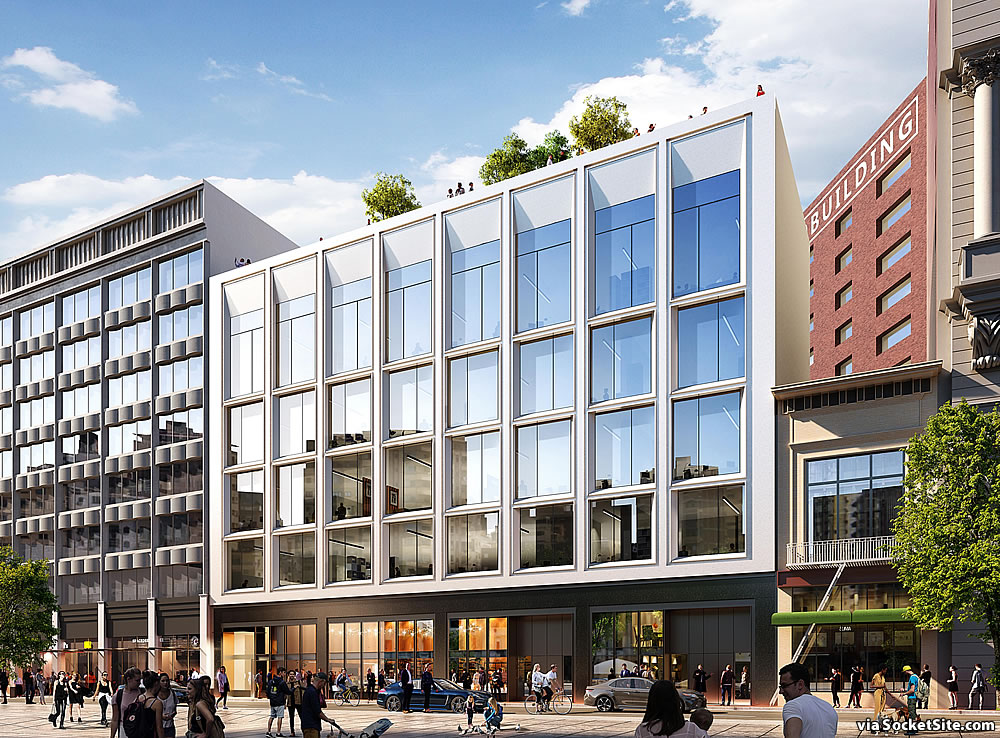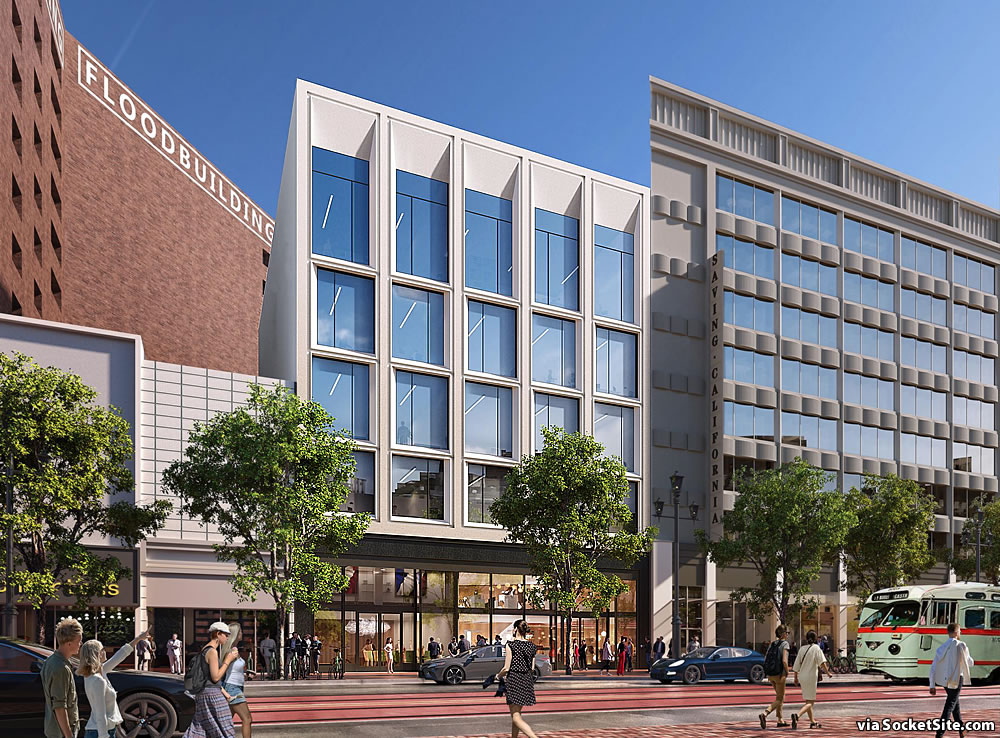Purchased for $30 million, or roughly $725 per existing square foot, last year, plans to expand, renovate and modernize the five-story commercial building at 838 Market Street, which was built as a shoe store for Sommer & Kaufman in 1930 and was more recently occupied by Levi’s, have been drawn.
As proposed by Aralon Properties and drafted by OTJ Architects, a sixth story would be added to the building, which fronts both Market and Ellis; the interior and façades would be completely modernized; and the resultant redevelopment would yield roughly 30,000 square feet of retail space along with roughly 45,000 square feet of new…office space across the building’s top four floors with a new entrance for the office floors along Ellis, driven by basic economics versus “societal need.”





This was a much cited design back in the 30’s https://calisphere.org/item/8b015a3ee99c2922b97eac244a06720e/
It’s too bad the work can’t respect the original more (I realize, tho, unlike – say – the I Magnin building, it’s been remoeled beyond all recognition, so maybe there’s really nothing meaningful that can be done).
And insofar as the 30’s were – also – a bleak period for downtown SF, maybe we should just appreciate that someone is replicating history by showing faith and building something.
Great pic – also shows the loss of original detail on its neighbor to the northeast… and the *complete* loss of what looks like a great Moore’s building to its southwest.
I believe they were the same building; just different facade treatments for each tenant. The design
seems to have been a popular one for Hart Schaffner retailers, witness this Chicago brethern https://assets.isu.pub/document-structure/210122202836-64011be4a55856d3b6b7f4fabc2211cf/v1/70d4c72c07b5b86ff873b0e7ec71ddcd.jpg
Nice find. An early example of chain store / “formula retail” design uniformity.
“45,000 square feet of new…[punchline]”
‘”driven by basic economics versus “societal need.”’
Cab we get a coupla rimshots over here?!
When was there a Levis located there?
Levi’s was on the Ellis side of the bldg.
This begs the question – do “basic economics” dictate the need for more office space in SF? Is the structure currently occupied? Would zoning have allowed residential construction?
It’s not just large office users that are downsizing/leaving SF. Smaller users such as law firms and other professional services are embracing hybrid work with the concomitant reality of needing less of an office footprint. My CPA is in a smallish firm of 8. They are going to hybrid work and clients now have a choice of online or in-office consultations. To that end they are looking for a smaller space out in the Avenues.
Nice try , but as the site has stated
more times than I know how to count toseveral times, these decisions are guided by strict economics; so when they do NPV calculations to determine the respective values, and they put in those anticipated lease revenues, and costs, etc., there’s no guess work involved, or any kind of irrational thinking.I think the jury is still out on workers returning to offices. Just today, yet another large employer (Amazon) mandated 3x/week in office for essentially all of their office employees. And while I think it’s likely that a certain amount of flexibility and hybrid work will continue, it won’t surprise me if many businesses ultimately find it beneficial to return to 5x/week on site, mostly.
It isn’t zoning that precludes most office-to-residential conversions, it’s economics. Residential uses require light and air into most rooms, which generally isn’t possible in large-plated commercial buildings. There are buildings out there where residential conversions are feasible but I don’t think it’s going to be possible in the majority of office buildings.
We all got called in recently, Tue – Thu. Gap Inc. HQ. Probably 2-3k or more people back downtown.
The tide is turning back to less 100% remote and more in person hybrid flex, no doubt.
The big chiefs see other companies do it and they follow which creates momo and fomo. That on top of all the layoffs, the chiefs have the upper hand.
I’m not complaining I was getting a bit bored sitting in my house all day. I like 3 days in.
But point being SF is turning. Maybe we’ll see some cranes again soon. It’s been very boring downtown. Oceanwide finish up? The hub?? A few more teams at towers? That huge market / Beale project? By the fed building.
“Maybe we’ll see some cranes again soon.”
Yes, because what SF needs is lots more empty, neighborhood-killing, gentrifying condo-office skyscrapers.
>Yes, because what SF needs is lots more empty, neighborhood-killing, gentrifying condo-office skyscrapers.
Yeah, I miss the days of the highway overpasses and one-story tall carpet stores.
All those residents are really killing the vibes!
I wouldn’t want to be office leasing agent in SF right now. Going back to landlord with monthly activity reports, explaining why the space is still vacant.
“Hey, boss, we got a bunch more vacancies.”
“Why’s dat?”
“‘Seems like lotsa bidnesses are downsizin’, and they don’t wanna pay your high prices no more.”
“Well, sell ’em harder, you mug!”
“I dunno, maybe it’s time to start aggressive discounting?”
“Are you nuts?! Then all my current suckers will start wantin’ lower rents, too! Besides, RealPage is maximizing my profits with high rents AND high vacancy. Not to mention the tax advantages!”
“Well, it’s kind of a bad look, you know?”
“What do I care? You’re fired!”
If you bang your fingers harder into the keyboard while typing why oh why oh why perhaps the cosmos will perceive the requisite energy for butterfly effect, two beers. Just a thought.
If a sales agent cries at an empty open house, does anyone hear him or her?
Indeed, clearly you never saw a cliche you didn’t swipe left.
Does it beg the question?
Look at the aerial photo. The building shape, mid-block location, and surrounding buildings don’t really lend themselves to residential conversion. Long blank walls spanning Market and Ellis Streets.
SF doesn’t need more office inventory. High risk.
The “basic societal needs” is a funny line, both as the intended joke and by the unintended irony of showing how some social critics/activists miss the point. There exists an entity called “government” with the primary purpose of fulfilling “basic societal needs.” Whereas private businesses exist to make a profit, which certainly fulfills individual needs, and may or may not in the process also fulfill the basic needs of the larger society and its members.
The City of San Francisco is quite capable of collecting and directing taxes to finance the construction of subsidized housing either through a public housing authority or under contract with a nonprofit organization, and this could certainly be accomplished on a large scale, if this is what local residents demanded. And, to a certain extent, the city has undertaken efforts to do this, but in the face of such a pressing need for housing, the city’s efforts have been both entirely inadequate and terribly unambitious.
Vienna, Austria provides an excellent example of a long-standing social housing program begun in the early 1920’s whereby the city uses tax revenue to construct high quality and socially integrated subsidized housing in which more than 60% of its 1.8 million residents reside, including many middle-class individuals. While it took many decades for the city to build enough residential units to house the majority of its residents, many thousands of units were nonetheless constructed in the first decade of the program alone.
While any big initiative takes time, effort, determination and resources, the city has certainly risen to great challenges many times before. Building new housing is a hard thing that becomes a simple undertaking once the decision is made to focus the effort to do it. And, the lack of action or inadequate action by local government is itself a decision, tacitly endorsed by city residents, as to what are the community’s priorities.
It is San Francisco we are talking about. The amount of property that Vienna owns and operates beyond your average big city is astonishing. Sustained funding is one thing, but let’s focus on how this is only possible when all parties involved live to value this system and consistently keep out corruption, embezzlement/rent seeking, vandalism and sabotage.
I agree with this, would you agree with a law that would ‘make the use of non union labor encouraged without any repercussions in the building of 100 percent affordable housing that is built with tax dollars’ would you agree with this law if it came with a peer reviewed cost study that concludes that non union labor decreases the cost of the units by 40 percent?
I think everyone would carefully consider this after a law was in place that would make Wall St. investment banks amend all employment contracts to enforce the use of bonus clawbacks from runamok banksters when their institutions have to be bailed out with tax dollars following a bubble blown up by dodgy financial products those banksters sold. No one considering this legislation would need a study to conclude that avoding paying bonuses to the same people who caused the crisis would decreases the cost of said bailouts, and would have the benefit of not rewarding socially deleterious behavior by bad financial sector actors, to boot.
Office landlord has just defaulted on portfolio, includes 470,000-square-foot 650 California St. and the 260,000-square-foot 201 California St. Are dominoes starting to fall?